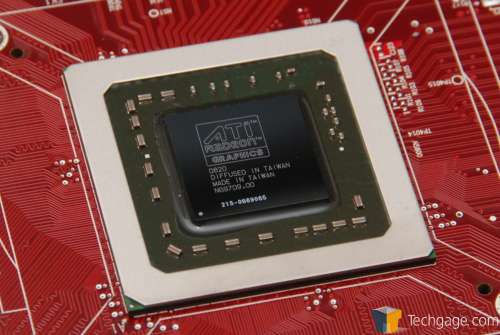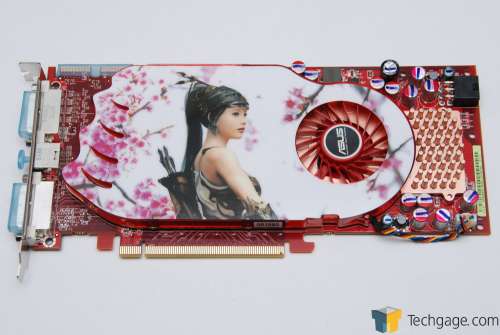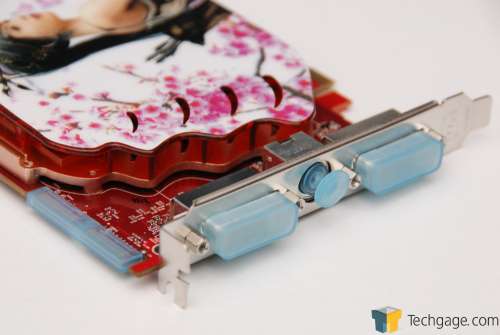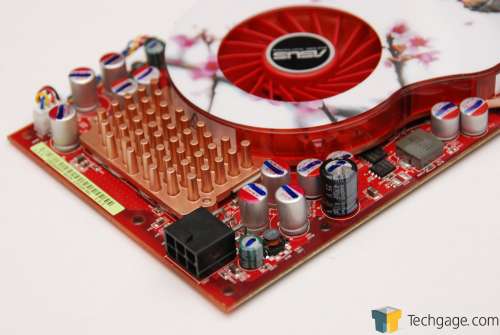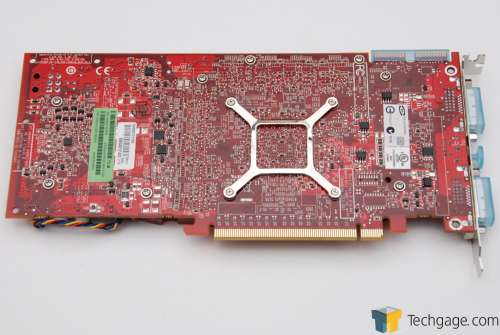- Qualcomm Launches Snapdragon 4 Gen 2 Mobile Platform
- AMD Launches Ryzen PRO 7000 Series Mobile & Desktop Platform
- Intel Launches Sleek Single-Slot Arc Pro A60 Workstation Graphics Card
- NVIDIA Announces Latest Ada Lovelace Additions: GeForce RTX 4060 Ti & RTX 4060
- Maxon Redshift With AMD Radeon GPU Rendering Support Now Available
ASUS EAH4850 512MB
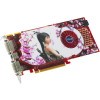
Proper competition from AMD in the mid-range scheme of things might have taken a while to happen, but it does happen with the HD 4000 series. We are taking a look at the smaller of the two new models, which offers exceptional performance for the price of $200.
Page 1 – Introduction, Closer Look
Right this moment, the GPU industry is at one of its most exciting points in history. Both AMD and NVIDIA, and even Intel, are going head-to-head-to-head with different ideas of what makes a GPU great. Well, for most enthusiasts, being fast is what makes a GPU great, and right now, AMD has a reason to gloat.
It’s been quite a while since AMD has released a part to equal or at least come close to one of NVIDIA’s higher-end offerings, but today marks the day when that happens. The HD 4850 and HD 4870 are proper mid-range cards, and right now, they happen to be the fastest single-GPU cards out there – at least out of those that are commercially available.
NVIDIA has their upgraded 9800 GTX, the 9800 GTX+, right around the corner, and once that’s released, the situations might change a little bit. It’s supposed to be priced above the $200 point of the HD 4850, but is supposed to show consistent improvements all-around. Initial results show consistent 15% performance increases, and for $30, that’s not so bad.
It will all come down to pricing, as usual, but that’s a good thing. Both companies will fight for your dollars, and as a result, you will wind up with a product that feels like it’s worth a lot more than what you paid for it.
Closer Look at the ATI Radeon HD 4850
AMD haven’t released a light upgrade, but rather a significant one with the HD 4000 series. The transistor count has been bumped up to 956 million, from 666 million, still based on the 55nm process. Both of the new cards, along with the future models, support DX 10.1 along with PCI-E 2.0. One new feature lays with the HD 4870, GDDR5. These chips are still fresh and come direct from Qimonda.
Arguably the most significant upgrade is the bump in stream processors. While the HD 3870 / 3850 both featured 320, the new cards feature an incredible 800. This is likely most responsible for the transistor increase.
The HD 4870 clocks in at 750MHz, while the HD 4850 is a bit more modest at 625 MHz. Even with the lower clock speed, though, the card is capable of 1.0 TeraFLOPS worth of math crunching ability. That makes AMD the first, and boy have they been touting the fact. Now we just need a reason on our home computers to exploit such power. We can’t just sit around and crunch advanced math problems all day!
|
Model
|
Core MHz
|
Mem MHz
|
Memory
|
Bus Width
|
Stream Proc.
|
| HD 3870 X2 |
825
|
900
|
2x512MB
|
256-bit
|
320
|
| HD 3850 X2 |
666
|
828
|
2x512MB
|
256-bit
|
320
|
| HD 4870 |
750
|
900
|
512MB
|
256-bit
|
800
|
| HD 4850 |
625
|
993
|
512MB
|
256-bit
|
800
|
| HD 3870 |
775
|
900
|
512MB
|
256-bit
|
320
|
| HD 3850 |
666
|
828
|
512MB
|
256-bit
|
320
|
| HD 3650 |
725
|
800
|
256,512MB
|
128-bit
|
120
|
| HD 3450 |
600
|
500
|
256MB
|
64-bit
|
40
|
All the stats aside, what matters is that these cards are fast, and at $200 for the HD 4850 and $299 for the HD 4870, they almost seem like relative steals.
While we aren’t taking a look at the HD 4870 today, we are taking the ASUS EAH4850 for a spin. Their card, like most of the others, follow the reference design perfectly, so you can expect our results to closely mimic any other HD 4850 out there. What the purchase will come down to is whatever heatsink you like most, or the warranties that are available.
The card features dual DVI ports, which has pretty well been the standard for a while, and also a TV-Out. For those who want HDMI output, ASUS includes such an adapter in the box.
This card is designed to compete head-to-head with NVIDIA’s 9800 GTX, but I already see one killer advantage of the HD 4850 – one 6-pin power connector. In our review of the 9800 GTX, my prime complaint was the fact that it required two separate power connectors, when it really wasn’t needed.
There’s a lot going on in the back, with a total of twelve screws that need to be removed in order to see what’s underneath the cooler.
As for accessories, ASUS has included an adapter to convert a molex power connector into a PCI-E 6-Pin, TV-Out/Component, TV-Out RCA, DVI-to-HDMI adapter, DVI-to-VGA adapter and also a Crossfire bridge. They’ve pretty much covered all of the bases here.
On the next page, we’ll tackle our testing methodology. If you haven’t read one of our GPU reviews before, we highly recommend you read through as we conduct testing differently than most other sites.
Support our efforts! With ad revenue at an all-time low for written websites, we're relying more than ever on reader support to help us continue putting so much effort into this type of content. You can support us by becoming a Patron, or by using our Amazon shopping affiliate links listed through our articles. Thanks for your support!




